Define Our Future
12 July 2024

(Image: Adobe)
In previous weeks we’ve discussed China’s expanding role in space, and their cooperative strategy in order to harness new partnerships and build an alternative vision for the future of space development. Moreover, we have noted how China is closely aligning their objectives in space with their overall foreign policy strategy; working closely with the UN and building open cooperative platforms, such as their Tiangong space station or the lunar research station project (ILRS).
China has also detailed how they intend to take a leading role in planetary defence. Back in July 2022, they announced they had begun construction of a new high-definition deep-space observation facility as part of their efforts to safeguard Earth from threatening objects. The Fuyan or “China Compound Eye” project is due to be completed in 2025.
This week, we also learned of updates regarding China’s own asteroid deflection test mission, similar to the NASA Double Asteroid Redirection Test (DART) mission in 2022, when they successfully impacted Dimorphos, the moonlet of the asteroid Didymos. The NASA demonstration was a huge success, reducing Dimorphos’ orbit by 32 minutes. The success threshold was only 73 seconds.
China’s own test will follow a similar strategy. They will send two spacecraft; one to impact the target and the other to observe the asteroid and gather information. It also seems that the China National Space Administration (CNSA) have already chosen their target, named 2015 XF261, a 30-metre-wide near Earth asteroid. The mission is due to launch before 2030.
China’s Tianwen missions and race for Mars samples
Before that, China will launch their Tianwen-2 probe next year, after their successful Tianwen-1 mission launched in 2020, which led to China becoming only the third nation to perform a soft landing on Mars. Tianwen-2 will have a different objective, first heading for near-Earth asteroid 469219 (also named Kamo’oalewa) in order to collect samples and deliver them back to Earth within two and a half years. The test will also hopefully demonstrate technology capable of round-trip asteroid mining in future.
After successfully returning the samples, the probe is then due to use Earth’s gravity to propel itself to a main-belt comet, named 311P/PANSTARRS, where it will observe the object and collect data, reaching its target within around seven years.
In 2028, China will also launch Tianwen-3, a mission designed to retrieve samples from Mars. NASA have been facing budgetary issues, affecting the launch date of their own Mars Sample Return mission (MSR). In April they put a call out to industry for proposals on how to return samples more cheaply and before 2040.
While NASA may still be on track to be the first nation to return astronauts to the Moon, it seems that China are finding other ways to build and maintain leadership. Their sample return missions not only provide scientific resources to better understand the history of our solar system, but also pave the way for validating resource retrieval and utilisation technology. What’s more is that China seem willing to share this success on a global platform.
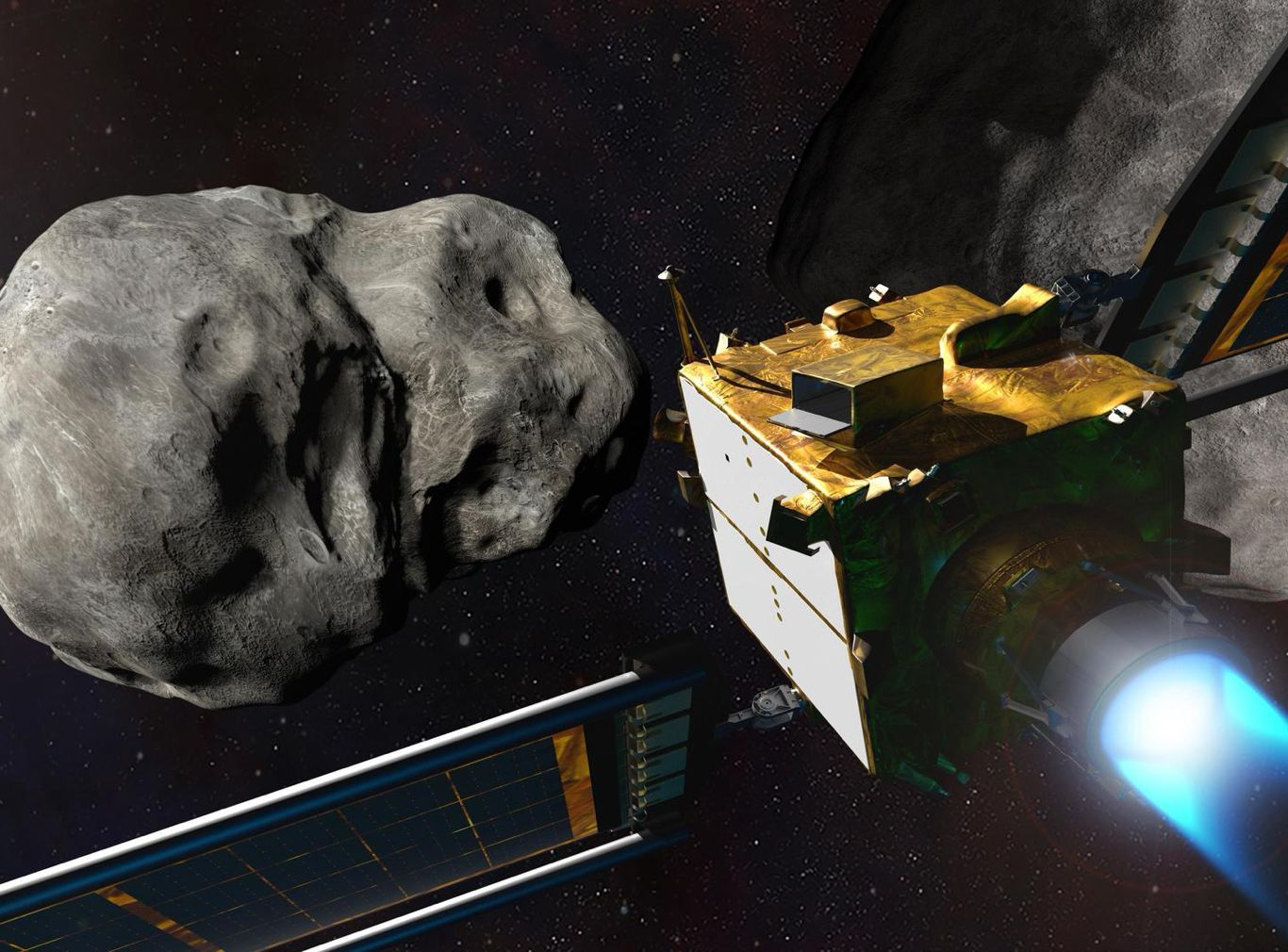
Illustration of DART mission (Image: NASA/Johns Hopkins APL/Steve Gribben)
ESA countdown for DART follow-up, NASA asteroid mission recap
In the days before the expected DART asteroid impact test, there was a rare show of support and unity from Chinese commentators, with Song Zhongping, a space watcher and TV commentator, telling the Global Times that “we have to view the matter from a higher standpoint, as it represents not only the US' technology advancement but also that of all human civilisation” (globaltimes.cn, 2022).
The European Space Agency (ESA) are also preparing to play their part in supporting the mission, and are now counting down to launch the follow-up mission to DART. ESA’s Hera spacecraft is due to launch in October this year and is part of their Space Safety programme. It will arrive at the Didymos system in around October 2026, and carry out a post-impact survey of the asteroid. According to ESA “Hera will turn the grand-scale experiment into a well-understood and repeatable planetary defence technique” (ESA).
NASA asteroid mission success, but need for industry input
NASA is also engaging in its own asteroid missions, most notably the launch of the Psyche mission in October last year. The probe is set to rendezvous with an asteroid of the same name to study its metallic nature and understand the origins of planetary cores, such as Earth's. The mission has garnered attention for the estimated value of the asteroid's resources, such as gold and platinum, with some reports suggesting it could be worth around $10 quintillion.
Of course, we are still some time away from validating technology capable of collecting and retrieving materials from outer space on a large scale. However, NASA successfully returned samples of asteroid Bennu as part of their OSIRIS-REx mission in September last year, marking a significant milestone in asteroid exploration and sample return.
NASA is also planning the OSIRIS-APEX mission, an extension of OSIRIS-REx. After delivering the Bennu samples back to Earth, the spacecraft still had fuel remaining. As a result, it will be repurposed to observe asteroid Apophis, which will pass within 32,000 kilometers of Earth's surface, closer than some geostationary satellites.
The probe will approach the asteroid after its close encounter and get within 5 meters of the surface. It will then use its thrusters to disturb the surface, providing scientists with a better understanding of its composition and an opportunity to observe what effects Earth's gravity has had on it.
A U.S. House spending bill report this week has also requested NASA to study the possibility of an additional mission to visit Apophis before its close approach. The report called for this mission to be a public-private partnership. In April, a workshop meeting in the Netherlands heard concepts from industry for an Apophis mission, including a proposal from Blue Origin. They suggested potentially using their Blue Ring spacecraft to approach the asteroid three months before its flyby.
While NASA has enjoyed success with recent asteroid missions, it faces competition from China, which is using its missions as a platform for global cooperation. Moving forward, NASA may need to rely more on the growing commercial sector, as it has done in the launch sector.

Ariane-6 launches for the first time (Image: ESA - S. Corvaja)
Europe Regain Independent Launch, Falcon-9 Suffers Rare Launch Malfunction
After years of delays, this week saw the first flight of Europe’s new Ariane-6 rocket, and the restoration of independant access to space. The rocket launched from French Guiana carrying satellites and various projects into orbit. The heavy-lift launcher was in its “A62” configuration, meaning it had two additional boosters, in addition to its first stage, upper stage and fairing. In its full “A64” configuration (4 additional boosters), it is capable of carrying up to 21.6 tonnes into low Earth orbit (LEO).
ESA’s head of space transportation strategy and institutional launches described the launch as an “historic moment”, while ESA head, Josef Aschbacher hailed the launch as a “big milestone”.
Not all went to plan, however. An anomaly in its final stage caused it to deviate from its planned trajectory and subsequently failed to reach the altitude needed to release its final payloads. Nonetheless, the vehicle did reach orbit for the first time, a notable success for a brand new rocket.
Chinese launch setbacks and concerns surrounding commercial technologies
Chinese commercial launch companies have suffered setbacks in recent weeks, more notable than the anomaly encountered by Ariane-6. On Wednesday, iSpace (also known as Beijing Interstellar Glory Space Technology Ltd) announced that they had experienced a problem with the fourth stage of their Hyperbola-1 solid rocket, resulting in the loss of three satellites and marking their fourth failure overall.
This follows the catastrophic failure experienced by Space Pioneer on June 30th. While carrying out a static fire test of their Tianlong-3 rocket, it unexpectedly took-off and crashed into the ground about 50 seconds later, creating a dramatic explosion. Prior to both of these, a Long March-C launch on June 22 led to toxic debris falling over a populated area.
These incidents will undoubtedly raise concerns about the safety of space-launch technology and the overall impact of space industry activities. Safety and sustainability, particularly concerning space debris, have been at the forefront of recent developments in the space sector and serve as bad PR for an industry aiming to rapidly expand.
Additionally, these incidents put pressure on China’s ambitious satellite delivery plans, with three different entities aiming to launch over 10,000 satellite mega-constellations. They may also cast doubt on China's commercial sector's ability to develop reusable launch technology and effectively compete with companies like SpaceX.
What will be the outcome of the failed Falcon-9 launch? Crisis or opportunity?
However, SpaceX, the world's leading space launch provider, has also experienced a rare anomaly this week. On July 11th, following a successful launch, observers noted an unusual buildup of ice around the upper stage engine of a Falcon 9 rocket. Elon Musk later indicated that the payload, a batch of Starlink satellites, was deployed, but the pedigree might have been too low for them to reach orbit.
This represents the first failure for Falcon-9 since 2016, and will be concerning for SpaceX, considering it is the workhorse of their fleet, relied upon by agencies and governments throughout the world. It also has implications for crewed flights, with Falcon-9 used to carry Crew Dragon capsules into space and to the ISS.
This incident may also serve as a reminder to some customers not to rely too heavily on a single supplier. Consequently, this could potentially be positive news for other launch providers.
The space launch sector is a rapidly expanding marketplace. Rocket Lab experienced a rare anomaly with its Electron rocket last year but has since resumed regular service. Just this week, Blue Origin and Stoke Space Technologies were selected as eligible launch providers for the US Space Force Orbital Services Program. Blue Origin is set to debut their competitor to Falcon 9, New Glenn, later this year. Additionally, on July 4th, Firefly Aerospace successfully placed 8 cubesats into orbit, marking a successful comeback after a launch failure six months ago.
In addition to the successful debut of Ariane-6, European nations will also soon have access to several new commercial launch options. In 2023, Sweden inaugurated its first commercial launch site in the Arctic and has recently signed deals with Perigee Aerospace from South Korea, who plan to launch their Blue Whale-1 rocket from there in 2025. Firefly Aerospace aims to begin launching their Alpha rocket from the same site starting in 2026. Norway and the UK are also preparing to become active launch nations, with inaugural launches anticipated as early as this year. This list goes on.
————————————————————
We have previously discussed the importance of avoiding over-reliance on SpaceX, particularly regarding technology politicisation and Elon Musk's forays into foreign policy matters. However, these recent incidents also serve as a reminder of the importance of diversity in supply chains. While there’s little doubt about SpaceX’s capability to recover swiftly, these incidents may remind some customers that it’s best to keep your options open, especially as our reliance on space increases.
Define Our Future

(Image: Adobe)
12 July 2024
Asteroid Exploration and Planetary Defence Missions, Opportunities and Threats in Wake of Launch Failures - Space News Roundup

In previous weeks we’ve discussed China’s expanding role in space, and their cooperative strategy in order to harness new partnerships and build an alternative vision for the future of space development. Moreover, we have noted how China is closely aligning their objectives in space with their overall foreign policy strategy; working closely with the UN and building open cooperative platforms, such as their Tiangong space station or the lunar research station project (ILRS).
China has also detailed how they intend to take a leading role in planetary defence. Back in July 2022, they announced they had begun construction of a new high-definition deep-space observation facility as part of their efforts to safeguard Earth from threatening objects. The Fuyan or “China Compound Eye” project is due to be completed in 2025.
This week, we also learned of updates regarding China’s own asteroid deflection test mission, similar to the NASA Double Asteroid Redirection Test (DART) mission in 2022, when they successfully impacted Dimorphos, the moonlet of the asteroid Didymos. The NASA demonstration was a huge success, reducing Dimorphos’ orbit by 32 minutes. The success threshold was only 73 seconds.
China’s own test will follow a similar strategy. They will send two spacecraft; one to impact the target and the other to observe the asteroid and gather information. It also seems that the China National Space Administration (CNSA) have already chosen their target, named 2015 XF261, a 30-metre-wide near Earth asteroid. The mission is due to launch before 2030.
China’s Tianwen missions and race for Mars samples
Before that, China will launch their Tianwen-2 probe next year, after their successful Tianwen-1 mission launched in 2020, which led to China becoming only the third nation to perform a soft landing on Mars. Tianwen-2 will have a different objective, first heading for near-Earth asteroid 469219 (also named Kamo’oalewa) in order to collect samples and deliver them back to Earth within two and a half years. The test will also hopefully demonstrate technology capable of round-trip asteroid mining in future.
After successfully returning the samples, the probe is then due to use Earth’s gravity to propel itself to a main-belt comet, named 311P/PANSTARRS, where it will observe the object and collect data, reaching its target within around seven years.
In 2028, China will also launch Tianwen-3, a mission designed to retrieve samples from Mars. NASA have been facing budgetary issues, affecting the launch date of their own Mars Sample Return mission (MSR). In April they put a call out to industry for proposals on how to return samples more cheaply and before 2040.
While NASA may still be on track to be the first nation to return astronauts to the Moon, it seems that China are finding other ways to build and maintain leadership. Their sample return missions not only provide scientific resources to better understand the history of our solar system, but also pave the way for validating resource retrieval and utilisation technology. What’s more is that China seem willing to share this success on a global platform.
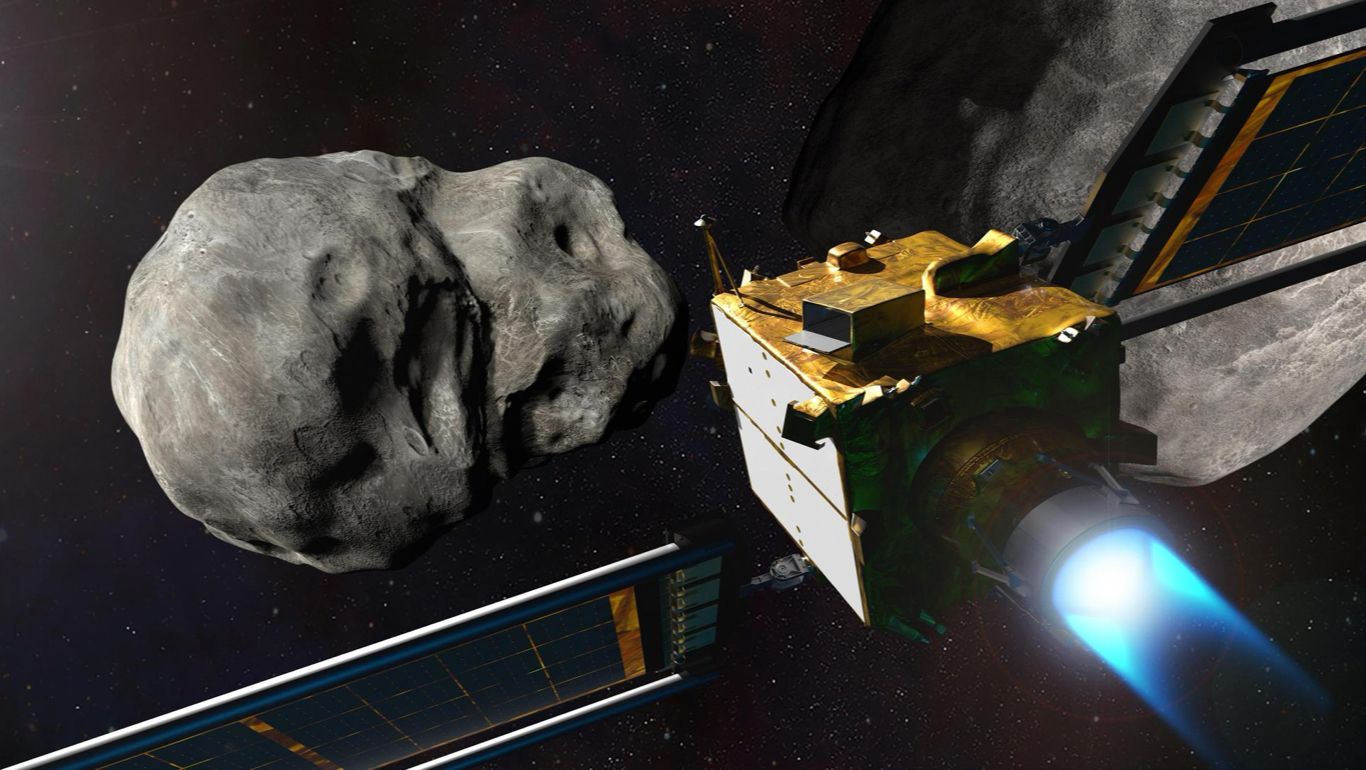
Illustration of DART mission (Image: NASA/Johns Hopkins APL/Steve Gribben)
ESA countdown for DART follow-up, NASA asteroid mission recap
In the days before the expected DART asteroid impact test, there was a rare show of support and unity from Chinese commentators, with Song Zhongping, a space watcher and TV commentator, telling the Global Times that “we have to view the matter from a higher standpoint, as it represents not only the US' technology advancement but also that of all human civilisation” (globaltimes.cn, 2022).
The European Space Agency (ESA) are also preparing to play their part in supporting the mission, and are now counting down to launch the follow-up mission to DART. ESA’s Hera spacecraft is due to launch in October this year and is part of their Space Safety programme. It will arrive at the Didymos system in around October 2026, and carry out a post-impact survey of the asteroid. According to ESA “Hera will turn the grand-scale experiment into a well-understood and repeatable planetary defence technique” (ESA).
NASA asteroid mission success, but need for industry input
NASA is also engaging in its own asteroid missions, most notably the launch of the Psyche mission in October last year. The probe is set to rendezvous with an asteroid of the same name to study its metallic nature and understand the origins of planetary cores, such as Earth's. The mission has garnered attention for the estimated value of the asteroid's resources, such as gold and platinum, with some reports suggesting it could be worth around $10 quintillion.
Of course, we are still some time away from validating technology capable of collecting and retrieving materials from outer space on a large scale. However, NASA successfully returned samples of asteroid Bennu as part of their OSIRIS-REx mission in September last year, marking a significant milestone in asteroid exploration and sample return.
NASA is also planning the OSIRIS-APEX mission, an extension of OSIRIS-REx. After delivering the Bennu samples back to Earth, the spacecraft still had fuel remaining. As a result, it will be repurposed to observe asteroid Apophis, which will pass within 32,000 kilometers of Earth's surface, closer than some geostationary satellites.
The probe will approach the asteroid after its close encounter and get within 5 meters of the surface. It will then use its thrusters to disturb the surface, providing scientists with a better understanding of its composition and an opportunity to observe what effects Earth's gravity has had on it.
A U.S. House spending bill report this week has also requested NASA to study the possibility of an additional mission to visit Apophis before its close approach. The report called for this mission to be a public-private partnership. In April, a workshop meeting in the Netherlands heard concepts from industry for an Apophis mission, including a proposal from Blue Origin. They suggested potentially using their Blue Ring spacecraft to approach the asteroid three months before its flyby.
While NASA has enjoyed success with recent asteroid missions, it faces competition from China, which is using its missions as a platform for global cooperation. Moving forward, NASA may need to rely more on the growing commercial sector, as it has done in the launch sector.
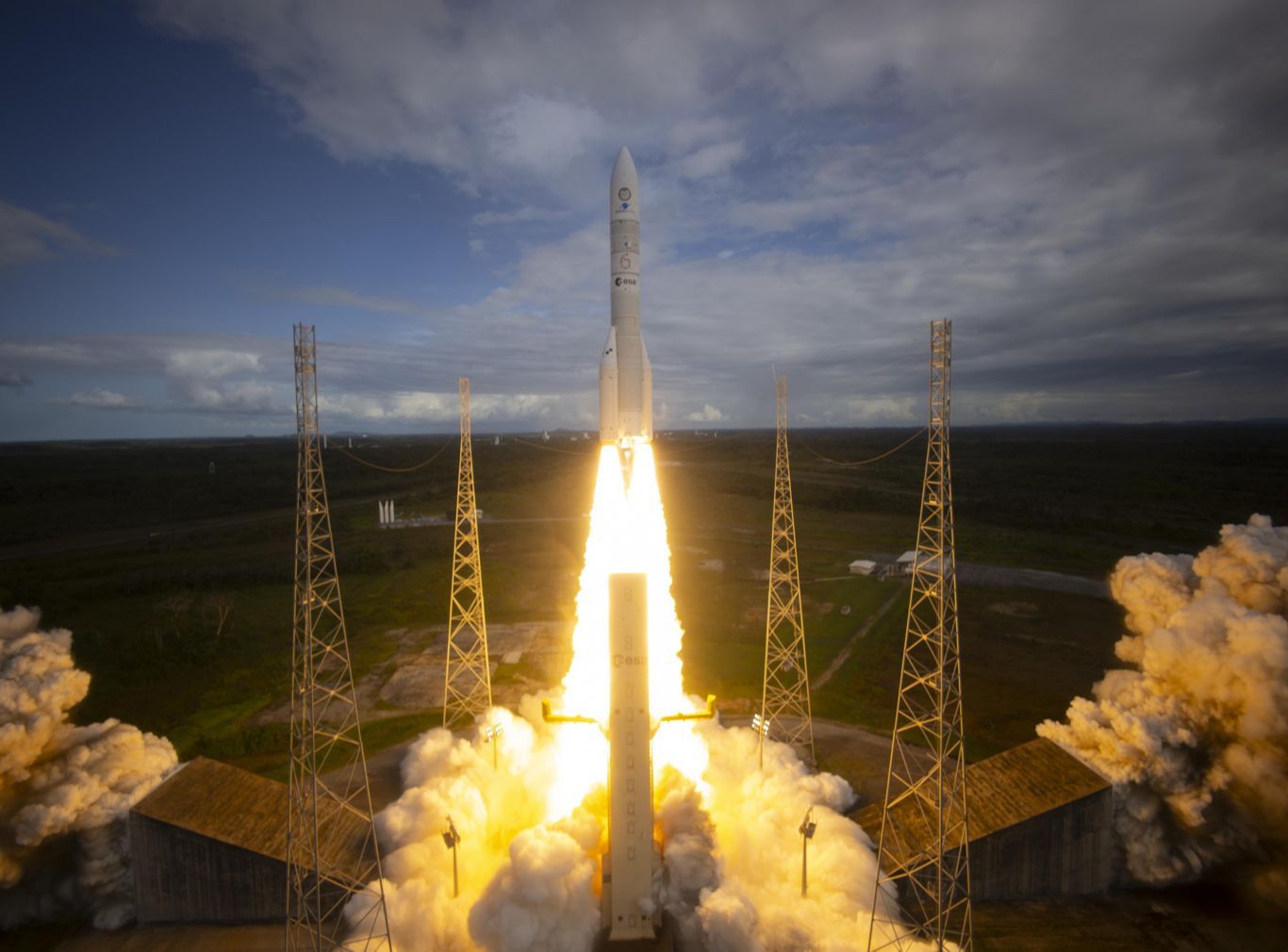
Ariane-6 launches for the first time (Image: ESA - S. Corvaja)
Europe Regain Independent Launch, Falcon-9 Suffers Rare Launch Malfunction
After years of delays, this week saw the first flight of Europe’s new Ariane-6 rocket, and the restoration of independant access to space. The rocket launched from French Guiana carrying satellites and various projects into orbit. The heavy-lift launcher was in its “A62” configuration, meaning it had two additional boosters, in addition to its first stage, upper stage and fairing. In its full “A64” configuration (4 additional boosters), it is capable of carrying up to 21.6 tonnes into low Earth orbit (LEO).
ESA’s head of space transportation strategy and institutional launches described the launch as an “historic moment”, while ESA head, Josef Aschbacher hailed the launch as a “big milestone”.
Not all went to plan, however. An anomaly in its final stage caused it to deviate from its planned trajectory and subsequently failed to reach the altitude needed to release its final payloads. Nonetheless, the vehicle did reach orbit for the first time, a notable success for a brand new rocket.
Chinese launch setbacks and concerns surrounding commercial technologies
Chinese commercial launch companies have suffered setbacks in recent weeks, more notable than the anomaly encountered by Ariane-6. On Wednesday, iSpace (also known as Beijing Interstellar Glory Space Technology Ltd) announced that they had experienced a problem with the fourth stage of their Hyperbola-1 solid rocket, resulting in the loss of three satellites and marking their fourth failure overall.
This follows the catastrophic failure experienced by Space Pioneer on June 30th. While carrying out a static fire test of their Tianlong-3 rocket, it unexpectedly took-off and crashed into the ground about 50 seconds later, creating a dramatic explosion. Prior to both of these, a Long March-C launch on June 22 led to toxic debris falling over a populated area.
These incidents will undoubtedly raise concerns about the safety of space-launch technology and the overall impact of space industry activities. Safety and sustainability, particularly concerning space debris, have been at the forefront of recent developments in the space sector and serve as bad PR for an industry aiming to rapidly expand.
Additionally, these incidents put pressure on China’s ambitious satellite delivery plans, with three different entities aiming to launch over 10,000 satellite mega-constellations. They may also cast doubt on China's commercial sector's ability to develop reusable launch technology and effectively compete with companies like SpaceX.
What will be the outcome of the failed Falcon-9 launch? Crisis or opportunity?
However, SpaceX, the world's leading space launch provider, has also experienced a rare anomaly this week. On July 11th, following a successful launch, observers noted an unusual buildup of ice around the upper stage engine of a Falcon 9 rocket. Elon Musk later indicated that the payload, a batch of Starlink satellites, was deployed, but the pedigree might have been too low for them to reach orbit.
This represents the first failure for Falcon-9 since 2016, and will be concerning for SpaceX, considering it is the workhorse of their fleet, relied upon by agencies and governments throughout the world. It also has implications for crewed flights, with Falcon-9 used to carry Crew Dragon capsules into space and to the ISS.
This incident may also serve as a reminder to some customers not to rely too heavily on a single supplier. Consequently, this could potentially be positive news for other launch providers.
The space launch sector is a rapidly expanding marketplace. Rocket Lab experienced a rare anomaly with its Electron rocket last year but has since resumed regular service. Just this week, Blue Origin and Stoke Space Technologies were selected as eligible launch providers for the US Space Force Orbital Services Program. Blue Origin is set to debut their competitor to Falcon 9, New Glenn, later this year. Additionally, on July 4th, Firefly Aerospace successfully placed 8 cubesats into orbit, marking a successful comeback after a launch failure six months ago.
In addition to the successful debut of Ariane-6, European nations will also soon have access to several new commercial launch options. In 2023, Sweden inaugurated its first commercial launch site in the Arctic and has recently signed deals with Perigee Aerospace from South Korea, who plan to launch their Blue Whale-1 rocket from there in 2025. Firefly Aerospace aims to begin launching their Alpha rocket from the same site starting in 2026. Norway and the UK are also preparing to become active launch nations, with inaugural launches anticipated as early as this year. This list goes on.
————————————————————
We have previously discussed the importance of avoiding over-reliance on SpaceX, particularly regarding technology politicisation and Elon Musk's forays into foreign policy matters. However, these recent incidents also serve as a reminder of the importance of diversity in supply chains. While there’s little doubt about SpaceX’s capability to recover swiftly, these incidents may remind some customers that it’s best to keep your options open, especially as our reliance on space increases.
Share this article
12 July 2024
Asteroid Exploration and Planetary Defence Missions, Opportunities and Threats in Wake of Launch Failures - Space News Roundup


(Image: Adobe)
In previous weeks we’ve discussed China’s expanding role in space, and their cooperative strategy in order to harness new partnerships and build an alternative vision for the future of space development. Moreover, we have noted how China is closely aligning their objectives in space with their overall foreign policy strategy; working closely with the UN and building open cooperative platforms, such as their Tiangong space station or the lunar research station project (ILRS).
China has also detailed how they intend to take a leading role in planetary defence. Back in July 2022, they announced they had begun construction of a new high-definition deep-space observation facility as part of their efforts to safeguard Earth from threatening objects. The Fuyan or “China Compound Eye” project is due to be completed in 2025.
This week, we also learned of updates regarding China’s own asteroid deflection test mission, similar to the NASA Double Asteroid Redirection Test (DART) mission in 2022, when they successfully impacted Dimorphos, the moonlet of the asteroid Didymos. The NASA demonstration was a huge success, reducing Dimorphos’ orbit by 32 minutes. The success threshold was only 73 seconds.
China’s own test will follow a similar strategy. They will send two spacecraft; one to impact the target and the other to observe the asteroid and gather information. It also seems that the China National Space Administration (CNSA) have already chosen their target, named 2015 XF261, a 30-metre-wide near Earth asteroid. The mission is due to launch before 2030.
China’s Tianwen missions and race for Mars samples
Before that, China will launch their Tianwen-2 probe next year, after their successful Tianwen-1 mission launched in 2020, which led to China becoming only the third nation to perform a soft landing on Mars. Tianwen-2 will have a different objective, first heading for near-Earth asteroid 469219 (also named Kamo’oalewa) in order to collect samples and deliver them back to Earth within two and a half years. The test will also hopefully demonstrate technology capable of round-trip asteroid mining in future.
After successfully returning the samples, the probe is then due to use Earth’s gravity to propel itself to a main-belt comet, named 311P/PANSTARRS, where it will observe the object and collect data, reaching its target within around seven years.
In 2028, China will also launch Tianwen-3, a mission designed to retrieve samples from Mars. NASA have been facing budgetary issues, affecting the launch date of their own Mars Sample Return mission (MSR). In April they put a call out to industry for proposals on how to return samples more cheaply and before 2040.
While NASA may still be on track to be the first nation to return astronauts to the Moon, it seems that China are finding other ways to build and maintain leadership. Their sample return missions not only provide scientific resources to better understand the history of our solar system, but also pave the way for validating resource retrieval and utilisation technology. What’s more is that China seem willing to share this success on a global platform.
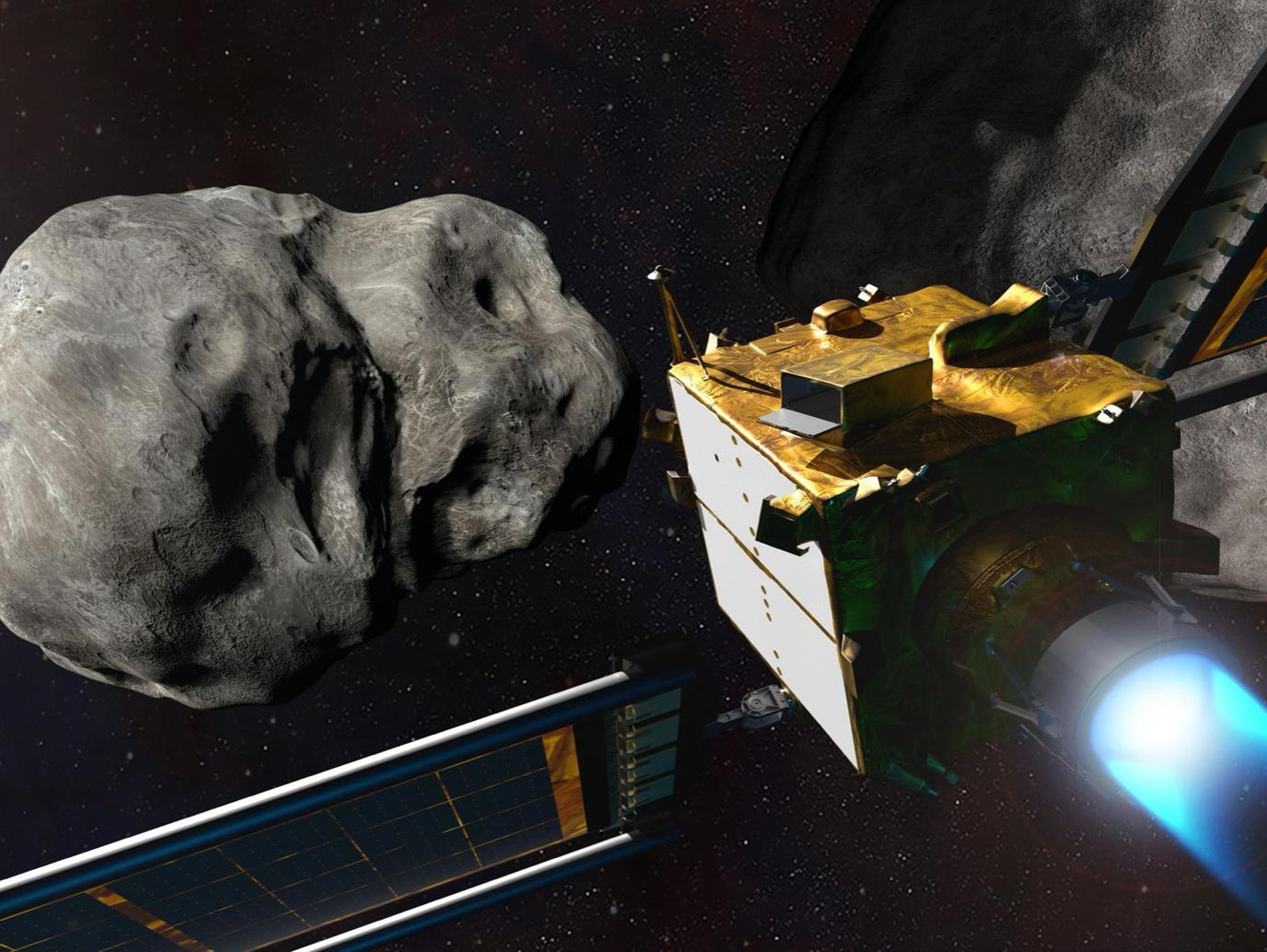
Illustration of DART mission (Image: NASA/Johns Hopkins APL/Steve Gribben)
ESA countdown for DART follow-up, NASA asteroid mission recap
In the days before the expected DART asteroid impact test, there was a rare show of support and unity from Chinese commentators, with Song Zhongping, a space watcher and TV commentator, telling the Global Times that “we have to view the matter from a higher standpoint, as it represents not only the US' technology advancement but also that of all human civilisation” (globaltimes.cn, 2022).
The European Space Agency (ESA) are also preparing to play their part in supporting the mission, and are now counting down to launch the follow-up mission to DART. ESA’s Hera spacecraft is due to launch in October this year and is part of their Space Safety programme. It will arrive at the Didymos system in around October 2026, and carry out a post-impact survey of the asteroid. According to ESA “Hera will turn the grand-scale experiment into a well-understood and repeatable planetary defence technique” (ESA).
NASA asteroid mission success, but need for industry input
NASA is also engaging in its own asteroid missions, most notably the launch of the Psyche mission in October last year. The probe is set to rendezvous with an asteroid of the same name to study its metallic nature and understand the origins of planetary cores, such as Earth's. The mission has garnered attention for the estimated value of the asteroid's resources, such as gold and platinum, with some reports suggesting it could be worth around $10 quintillion.
Of course, we are still some time away from validating technology capable of collecting and retrieving materials from outer space on a large scale. However, NASA successfully returned samples of asteroid Bennu as part of their OSIRIS-REx mission in September last year, marking a significant milestone in asteroid exploration and sample return.
NASA is also planning the OSIRIS-APEX mission, an extension of OSIRIS-REx. After delivering the Bennu samples back to Earth, the spacecraft still had fuel remaining. As a result, it will be repurposed to observe asteroid Apophis, which will pass within 32,000 kilometers of Earth's surface, closer than some geostationary satellites.
The probe will approach the asteroid after its close encounter and get within 5 meters of the surface. It will then use its thrusters to disturb the surface, providing scientists with a better understanding of its composition and an opportunity to observe what effects Earth's gravity has had on it.
A U.S. House spending bill report this week has also requested NASA to study the possibility of an additional mission to visit Apophis before its close approach. The report called for this mission to be a public-private partnership. In April, a workshop meeting in the Netherlands heard concepts from industry for an Apophis mission, including a proposal from Blue Origin. They suggested potentially using their Blue Ring spacecraft to approach the asteroid three months before its flyby.
While NASA has enjoyed success with recent asteroid missions, it faces competition from China, which is using its missions as a platform for global cooperation. Moving forward, NASA may need to rely more on the growing commercial sector, as it has done in the launch sector.
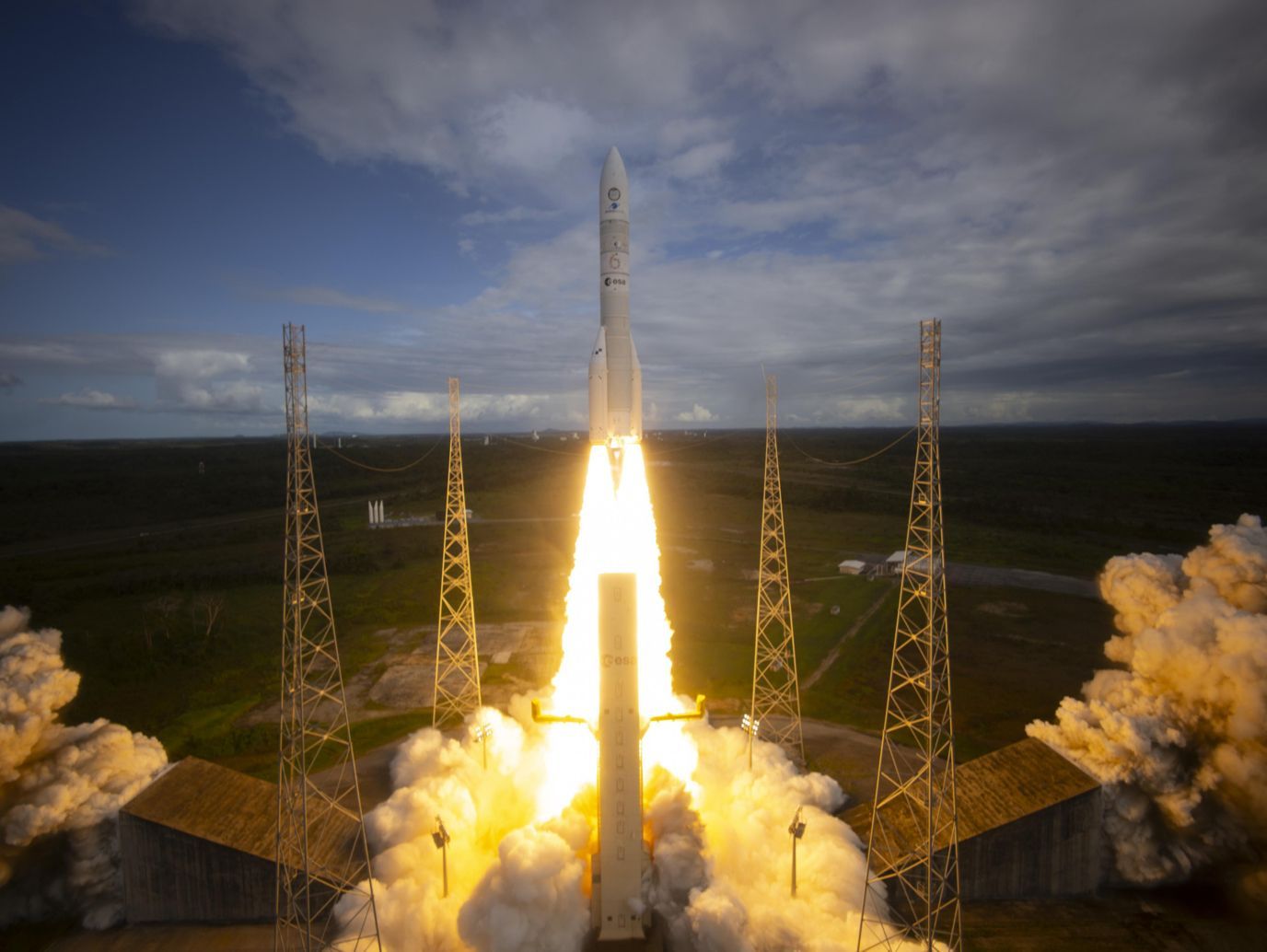
Ariane-6 launches for the first time (Image: ESA - S. Corvaja)
Europe Regain Independent Launch, Falcon-9 Suffers Rare Launch Malfunction
After years of delays, this week saw the first flight of Europe’s new Ariane-6 rocket, and the restoration of independant access to space. The rocket launched from French Guiana carrying satellites and various projects into orbit. The heavy-lift launcher was in its “A62” configuration, meaning it had two additional boosters, in addition to its first stage, upper stage and fairing. In its full “A64” configuration (4 additional boosters), it is capable of carrying up to 21.6 tonnes into low Earth orbit (LEO).
ESA’s head of space transportation strategy and institutional launches described the launch as an “historic moment”, while ESA head, Josef Aschbacher hailed the launch as a “big milestone”.
Not all went to plan, however. An anomaly in its final stage caused it to deviate from its planned trajectory and subsequently failed to reach the altitude needed to release its final payloads. Nonetheless, the vehicle did reach orbit for the first time, a notable success for a brand new rocket.
Chinese launch setbacks and concerns surrounding commercial technologies
Chinese commercial launch companies have suffered setbacks in recent weeks, more notable than the anomaly encountered by Ariane-6. On Wednesday, iSpace (also known as Beijing Interstellar Glory Space Technology Ltd) announced that they had experienced a problem with the fourth stage of their Hyperbola-1 solid rocket, resulting in the loss of three satellites and marking their fourth failure overall.
This follows the catastrophic failure experienced by Space Pioneer on June 30th. While carrying out a static fire test of their Tianlong-3 rocket, it unexpectedly took-off and crashed into the ground about 50 seconds later, creating a dramatic explosion. Prior to both of these, a Long March-C launch on June 22 led to toxic debris falling over a populated area.
These incidents will undoubtedly raise concerns about the safety of space-launch technology and the overall impact of space industry activities. Safety and sustainability, particularly concerning space debris, have been at the forefront of recent developments in the space sector and serve as bad PR for an industry aiming to rapidly expand.
Additionally, these incidents put pressure on China’s ambitious satellite delivery plans, with three different entities aiming to launch over 10,000 satellite mega-constellations. They may also cast doubt on China's commercial sector's ability to develop reusable launch technology and effectively compete with companies like SpaceX.
What will be the outcome of the failed Falcon-9 launch? Crisis or opportunity?
However, SpaceX, the world's leading space launch provider, has also experienced a rare anomaly this week. On July 11th, following a successful launch, observers noted an unusual buildup of ice around the upper stage engine of a Falcon 9 rocket. Elon Musk later indicated that the payload, a batch of Starlink satellites, was deployed, but the pedigree might have been too low for them to reach orbit.
This represents the first failure for Falcon-9 since 2016, and will be concerning for SpaceX, considering it is the workhorse of their fleet, relied upon by agencies and governments throughout the world. It also has implications for crewed flights, with Falcon-9 used to carry Crew Dragon capsules into space and to the ISS.
This incident may also serve as a reminder to some customers not to rely too heavily on a single supplier. Consequently, this could potentially be positive news for other launch providers.
The space launch sector is a rapidly expanding marketplace. Rocket Lab experienced a rare anomaly with its Electron rocket last year but has since resumed regular service. Just this week, Blue Origin and Stoke Space Technologies were selected as eligible launch providers for the US Space Force Orbital Services Program. Blue Origin is set to debut their competitor to Falcon 9, New Glenn, later this year. Additionally, on July 4th, Firefly Aerospace successfully placed 8 cubesats into orbit, marking a successful comeback after a launch failure six months ago.
In addition to the successful debut of Ariane-6, European nations will also soon have access to several new commercial launch options. In 2023, Sweden inaugurated its first commercial launch site in the Arctic and has recently signed deals with Perigee Aerospace from South Korea, who plan to launch their Blue Whale-1 rocket from there in 2025. Firefly Aerospace aims to begin launching their Alpha rocket from the same site starting in 2026. Norway and the UK are also preparing to become active launch nations, with inaugural launches anticipated as early as this year. This list goes on.
————————————————————
We have previously discussed the importance of avoiding over-reliance on SpaceX, particularly regarding technology politicisation and Elon Musk's forays into foreign policy matters. However, these recent incidents also serve as a reminder of the importance of diversity in supply chains. While there’s little doubt about SpaceX’s capability to recover swiftly, these incidents may remind some customers that it’s best to keep your options open, especially as our reliance on space increases.
Share this article

